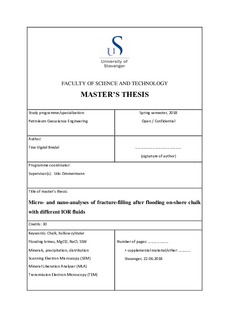| dc.contributor.advisor | Zimmermann, Udo | |
| dc.contributor.author | Bredal, Tine, Vigdel | |
| dc.date.accessioned | 2018-11-02T09:32:45Z | |
| dc.date.available | 2018-11-02T09:32:45Z | |
| dc.date.issued | 2018-06-22 | |
| dc.identifier.uri | http://hdl.handle.net/11250/2570733 | |
| dc.description | Master's thesis in Petroleum Geosciences Engineering | nb_NO |
| dc.description.abstract | Water injection into the Ekofisk-reservoir was introduced in 1987 to enhance oil recovery (EOR) dissolution and precipitation by exposing chalk to various brines at reservoir conditions, which further increased deformation of chalk matrix. This deformation affected mechanical properties of the tested samples and is referred to as water weakening of chalk.
This thesis has focused on identifying mineral changes and mapping the distribution of precipitated mineral during flooding of samples which have an artificial fracture and will compare hollow cylinder to intact chalk cores. Methods used to achieve a mineralogic map are:
• Optical Light Microscopy (OLM)
• Light microscopy (LM)
• X-ray diffraction (XRD)
• Scanning Electron Microscopy (SEM)
• Focused Ion Beam (FIB) sample for Transmission Electron Microscopy (TEM)
• Mineral Liberation Analyzer (MLA)
All cores tested, either intact or hollow and representing all combinations of brine injected, distributed an increased abundance of chlorite. The most sensational observation was the precipitation of magnesite inside the core of the hollow cylinder flooded by MgCl2, and the distinct boundary that this distribution created. Ilmenite was also observed at the same location, while calcite was limited to the matrix itself. Pyrite was not observed in the reference rock, but this was however identified in cores flooded by both MgCl2 and SSW. One non-fractured core injected by SSW experienced clogging after 20 days of flooding. The two samples from this core provided similar composition as the reference rock, hence the reduction of permeability was related to the composition of the brine (SSW) as the comparable core injected with MgCl2 experienced a more dramatic calcite dissolution. This core that clogged also experienced a rapid creep phase and imply that pores could have been clogged solely due to the compression and dissolution of grain to grain contacts during flooding.
These results, among others, allows an interpretation that dissolution of original grains and distribution of precipitated minerals is dependent on a variety of processes. The type of brine injected, distribution of porous network and the distance from the inlet are essential parameter which affect the precipitation in the hollow core, so verified in this study. The reactivity and the content of silicate and clay minerals may also influence the process. | nb_NO |
| dc.publisher | University of Stavanger, Norway | nb_NO |
| dc.relation.ispartofseries | Masteroppgave/UIS-TN-IER/2018; | |
| dc.subject | chalk | nb_NO |
| dc.subject | EOR | nb_NO |
| dc.subject | TEM | nb_NO |
| dc.subject | SEM | nb_NO |
| dc.subject | MLA | nb_NO |
| dc.subject | XRD | nb_NO |
| dc.subject | petroleumsgeologi | nb_NO |
| dc.subject | mineraler | nb_NO |
| dc.title | Micro- and nano-analyses of fracture-filling after flooding on-shore chalk with different IOR fluids | nb_NO |
| dc.type | Master thesis | nb_NO |
| dc.subject.nsi | VDP::Teknologi: 500::Berg‑ og petroleumsfag: 510::Geoteknikk: 513 | nb_NO |
| dc.subject.nsi | VDP::Matematikk og Naturvitenskap: 400::Geofag: 450::Petroleumsgeologi og -geofysikk: 464 | nb_NO |
